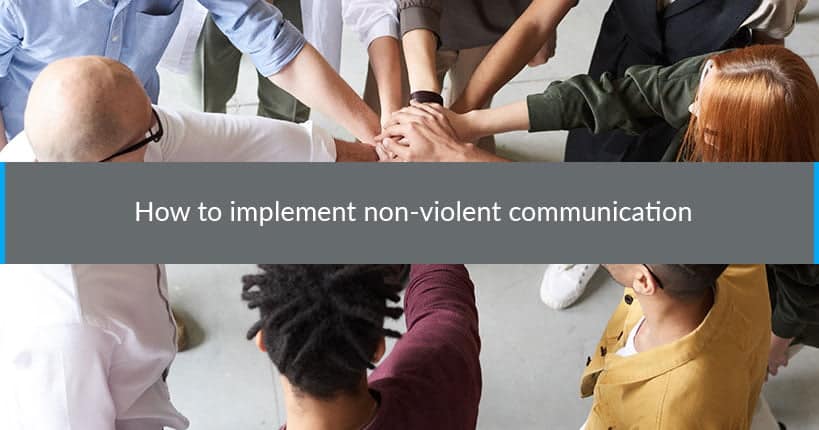“Words are windows, or they are walls. They either condemn us or set us free” – Marshall B. Rosenberg
Disparaging comments, reproaches or reprimands, the office can sometimes turn into a boxing ring where everyone takes turns throwing punches. It is often difficult to manage your mood and your relationships with others. Sometimes it doesn’t take much (being behind on work, an annoyed client, etc.) to trigger hurtful comment or to start a conflict that takes time to settle down.
In your professional life (as well as in your private life), communication is essential for giving instructions, making yourself understood, expressing your feelings, creating and maintaining harmonious relationships and defusing tensions and conflicts. All of this contributes to creating a pleasant and productive working environment.
To achieve a better balance between work and leisure, and foster healthy and caring relationships, adopt non-violent communication.
What is non-violent communication?
The concept of non-violent communication (or CNV) was developed in 1970 by the American psychologist Marshall B. Rosenberg, the student and colleague of Carl Rogers, the American psychologist who developed the person-centred approach.
This is a mainly verbal method of communication, based on qualities such as empathy, compassion, self-respect and respect for others which allow you to foster lasting relationships.
The expression ‘non-violent’, references the Ghandi movement and essentially refers to communicating with others without causing hurt or upset. As well as resolving conflicts, non-violent communication allows you to improve your relationship with yourself and with others, but also to better understand your deeper needs in order to achieve what you want to achieve.
CNV allows you to understand that the feelings and emotions you are feeling are neither caused by the situation you are facing nor by the behaviour of the other person, but by your own needs, which you need to address for your own well-being.
The 4 principles of CNV
In order to implement non-violent communication in your company, you should follow these four steps when you communicate with your co-workers :
- Observation: Observe the facts and describe the situation in an objective way, without judgement, without interpretation and without analysis.
- Feelings and attitudes: How do you feel about this situation? Express how you feel. For example, are you sad, frustrated, angry, disappointed, annoyed, impatient, worried, etc.?
- Needs: Identify and understand the causes of these feelings and explain these clearly to the person in question.
- Demands: Form concrete demands that allow the person to address your needs. Your demands should be positive, simple, clear, precise and realistic. Above all, they should be able to answer negatively without fearing reproach, otherwise your demand becomes a requirement not a request.
Be aware of the way in which you are expressing yourself. Generally, when you use more informal terms you tend to express judgements rather than your feelings.
To explain CNV, Marshall B. Rosenberg uses two animals to demonstrate the two types of communication generally used:
- The jackal represents communication that is traditionally deemed aggressive. Based on domination, this way of communicating seeks to convince using violence and manipulation techniques (guilt, shame, punishment, praise).
- The giraffe represents kind communication. According to Thomas d’Ansembourg, author of the book ‘Cessez d’être gentil, soyez vrai’, Marshall B. Rosenberg chose the giraffe because “it’s the land animal with the biggest heart and has very few enemies in the wild”.
An example
Lets exemplify non-violent communication. One of your co-workers often comes late to work and doesn’t warn ahead.
Rather than saying “you’re late again, its disrespectful to the entire team” (Communicating in jackal mode).
Here is what you should say to them in non-violent communication mode:
- Observation: “You always arrive at 10am even though everyone else starts at 9am”.
- Feeling: “I’m annoyed and disappointed”.
- Need: “The team needs loyalty and it is important that everyone works to the same schedule in order to maintain a cohesive team”.
- Demand: “Could you arrive on time tomorrow or warn ahead in case you are late?”
You are not being aggressive or looking to make the person feel guilty. You are presenting a fact and explaining how that person should change their attitude to contribute to the atmosphere of the team.
The advantages of CNV
Non-violent communication entails a number of benefits:
- You are learning to communicate in a non-judgmental way,
- You are learning to identify and understand your own needs, and how to express them,
- The person in question does not feel cornered or defensive,
- You are explaining your expectations clearly and avoiding misunderstandings,
- CNV encourages others to cooperate,
- It allows you to avoid conflict or to resolve conflict calmly and easily.
Conclusion
It’s true that a well-formulated and kind demand will have a better chance of success than a forceful, authoritative demand.
Non-violent communication will not come naturally to you to begin with, it is often not easy to express your feelings and your needs in a professional environment. This requires you to change your habits and work on yourself. However, you will improve through practice and quickly realise that this is a useful communication tool, that encourages kind and respectful discourse at work, like at home.










